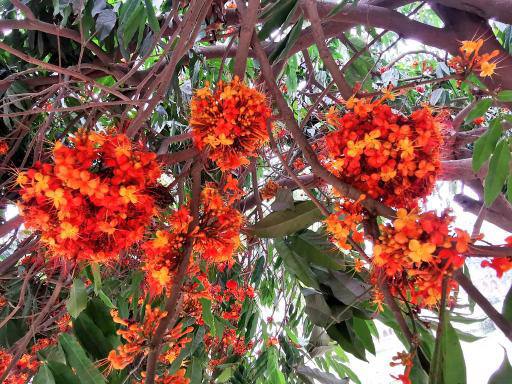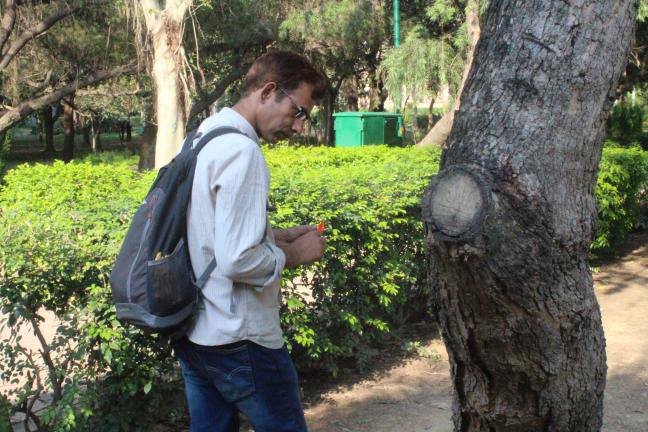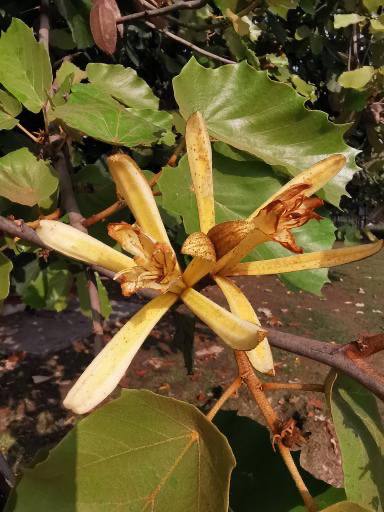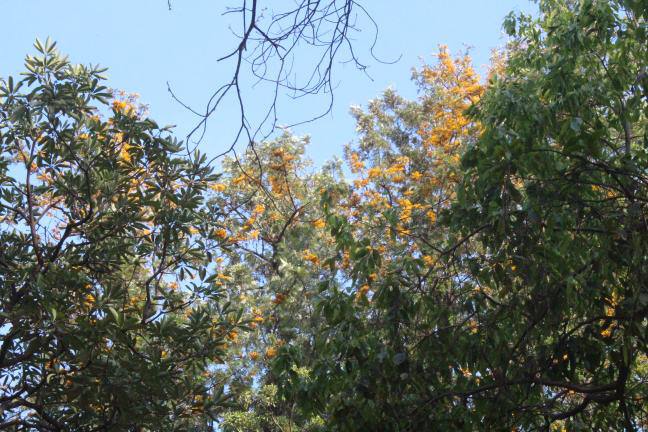Ashoka tree (Saraca asoca) is believed to have grown in Ashokavatika, the garden of Ravana. Legend has it that Sita found solace in the shade of the Ashoka tree while she was held captive in Ravana’s garden.
In Delhi’s Lodhi Gardens, there are a number of Ashoka trees. Some are in their nascent stage and some are blooming, their flowers annexed by armies of bees. They are often confused with ‘false Ashoka’ or Monoon longifolium. However, a cursory glance at their sophisticated flowers will inform you that they are the real Ashoka trees.
Krishna fig or Ficus krishnae has a pocket-like fold at the base of its leaves. It is believed that Lord Krishna used to roll the base to hide his stolen butter from his mother, Yashoda. Ever since, the leaves have retained their shape and the tree was named after him. On the other hand, the seeds of Putranjiva (Putranjiva roxburghii) are believed to cure infertility and increase the chances of a male child. One can spot people collecting the seeds to sell it for Rs 60 per kg in nearby areas of Delhi.

These are the interesting facts and observations that one comes to know while taking a walk with Chandan Tiwary, a nature-lover who runs the page Delhi Trees on Twitter and Instagram. Tiwary accompanies you in a complete reverie, ready to share both scientific information or urban legends associated with the trees. He has created a mental documentation of almost every tree in Delhi, and often spends his time visiting Delhi’s green havens.
“I always take the flowers of Kanak champa (Pterospermum acerifolium) with me. Their fragrance stays in the room for almost 6 days,” he says as he collects the yellow flower of the tree from the ground. “Do you see its leaves? It is also called the ‘dinner plate tree’ because of its huge, plate-like leaves.”
As he walks, he does not shy away from expressing his excitement to show you a Rudraksha tree (Elaeocarpus ganitrus) in the corner of the park or his disappointment about how visitors have ruined the Arjuna tree (Terminalia arjuna) because its bark is believed to treat heart problems. However, as he strolls and talks, he interrupts the conversation in between and asks you to bend down to smell a flower – giving you company.
“Refreshing, right? It feels like a discovery. I have asked my friend from Italy to send me a perfume made from this flower,” he says while smelling violets on the edge of a tree. The flowers have a sweet smell, with notes of earthiness.

There are a few general rules that he follows (and encourages you to follow):
“If you ever see a bottle brush tree (Callistemon), pluck three leaves, or maybe four, crush them and smell their fragrance. You will know what I am saying.”
“When you come across a dudhi tree (Wrightia tinctoria), always touch their leaves. They are silky and it feels so good to touch them”
“Whenever you see a tree is dying, always hug it. You will realize the connection you share with it.”
Tiwary makes the walk immersive, sharing his experiences with nature and keeping you busy to explore as much as you can.
“I always try to tell things about trees that people can relate with. If I just share the scientific information, they will lose track and get bored. I believe it is very important to relate with them in order to grow love for them,” Tiwary says.
He started in 2019 with his friend Syed Muhammad Qasim. Both the friends visited almost every park and forest of Delhi to document trees, often reading about them in books such as Pradip Krishen’s Trees Of Delhi. Over the years, he developed a deep love for them.

“It was difficult. Even though we wanted to know more about trees, nobody was there to tell us. Those who knew didn’t bother. We used to revisit places in order to document them. So, we thought maybe we should create a space where people can learn more about trees and build a relationship with them,” he says.
During the same time, he started his Instagram and Twitter pages, which over the years have become popular among nature lovers in the city. He goes on walks with all sorts of people, without any charge, just to promote love for trees among visitors.
“Students, professionals, scholars all ask me to take them on a walk. I love to share stories about nature. I think it is my way of giving back to nature,” he says.
Although Tiwary encourages to know more about the trees of Delhi, he maintains that the true beauty of many trees could only be realised when one visits the places of their origin.
“Most of the trees in Delhi are just specimens. If you really want to see how magnificent they can look, visit the place they have originated from. It will take your breath away,” he says.

Asked about how he remembers so many things about each of them, Tiwary says, “It has ingrained in my memory. I have observed them, read about them, hugged them. Now, they feel like a part of me.”
Apart from trees and flowers, he talks casually, often making jokes about his own “illiteracy” about nature before he started or how mechanical professional life becomes over a period of time. The walks are filled with laughter, conversations, and love for nature – which is also reflective on his social media pages.
Tiwary makes sure that you have a good time at the walk. So much so that when the walk ended, he pointed at a tree and asked, “Which tree is it?”
It came down to two look-alikes in the Gardens.
“It looks like a Jamun tree (Syzygium cumini) or Amaltas (Cassia fistula). But if you see closely, the branch is a little reddish, so it must be Amaltas,” he smiles.





